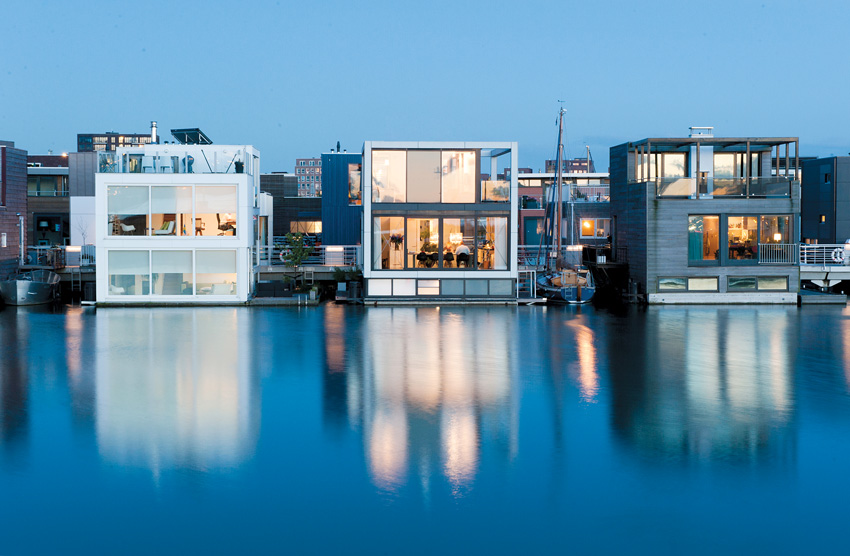Floating Buildings
Learning Objectives:
- Outline the range of solutions for flood-prone areas that involve living with water rather than trying to keep it out.
- Describe how marine technologies can be adapted to create floating buildings, islands, and public spaces.
- Outline the distinguishing characteristics of amphibious architecture.
- Discuss what makes floating islands an appropriate location for critical facilities and infrastructure in wet slums.
Credits:
View course on architecturalrecord.com »
As the ice melts and the seas rise, building on waterfront and flood-prone sites begins to look a lot like foolishness, yet backing away from the water takes more willpower than most cities and towns can muster. Ever since the first settlements took root on flood-fertilized riverbanks, next to the water is where people have always wanted to be.

PHOTOGRAPHY: © WATERSTUDIO
VILLA FLOTILLA
The floating houses designed by Waterstudio, which make up a neighborhood on Amsterdam’s Lake Ijssel, have “foundations” formed in a single pour to eliminate joints.
So what are the options for staying put and living with water rather than moving away from it? They range from keeping water out—with barriers, stilts, and raised ground planes—to letting water in, with ground floors designed for periodic inundation, to, ultimately, rising above it all, with floating architecture. Yes, really. “Whether it’s New York or London, Bangkok or Dhaka, all these cities are growing, all these cities are next to the water, and all are threatened by the water,” says Koen Olthuis, founding principal of Netherlands-based Waterstudio. “Floating developments can be part of the solution.”
The technology of floating architecture isn’t new. Each of the projects considered here uses tried-and-true technology adapted from marine applications to achieve its unusual results, whether it’s a floating house, an island, a church, or a plaza.
Houseboats, for example, have been around for centuries, and the floating houses that make up a neighborhood in Ijburg, under development in Amsterdam’s Lake Ijssel, are “really just better houseboats,” says Olthuis, “built to the same standards as a house on land, using the same methods and materials.”
For all their similarities to houses on terra firma, however, the float houses Olthuis has designed for Ijburg differ in a crucial aspect: their buoyant “foundations,” or lower levels. Formed in a single pour to eliminate joints, and emphatically free of cracks, a prefabricated concrete tub—or hull—is designed to displace a volume of water with a weight equivalent to the weight of the house. The hull is submerged the depth of half a story and secured to telescoping piles at diagonally opposite corners, allowing the house to rise and fall with the water but not wander about. (Typically, bedrooms are located on the partially submerged level, and the water reduces heating and cooling loads on the house.) As a refinement, automatic air-water balancing tanks help keep the house level when the residents invite more than a few friends to a party.
A buoyant foundation can also be used to build amphibious architecture on flood-prone land. Amphibious architecture retains a connection to the ground under ordinary circumstances and floats as high as needed when flooding occurs. As a flood-mitigation strategy, amphibious architecture works with natural cycles, instead of trying to resist them.
Waterstudio’s 1,440-square-foot Villa De Hoef, for example, usually sits in a garden beside a waterway in the small Dutch town of De Hoef. When the waterway floods, which happens every 10 years or so, the house floats; as the flood recedes, the house returns to its original position. With a maximum anticipated flood level for the site of only 4 feet, the project’s engineers deemed it safe to tether the house with cables and surround it with a wooden deck, in preference to telescoping piles. A skirt of nylon net prevents flood debris from becoming lodged beneath the house. “Low-tech, low-maintenance,” says Olthuis. Maintaining the amphibious system requires periodic visual inspection of the cables and deck, and, every five years, a recalculation of the house’s added or moved live load to determine and adjust its center of gravity. This is in case the occupants have accumulated more belongings or rearranged the furniture.

IMAGES: © WATERSTUDIO
NOT ALL WET
The Waterstudio’s Villa De Hoef (left), in the Netherlands, normally sits on dry ground alongside a waterway. But when it floods, the house floats. A developer is currently seeking zoning approval to build 29 Waterstudio-designed private floating islands (right) on an inlet north of Miami Beach.









